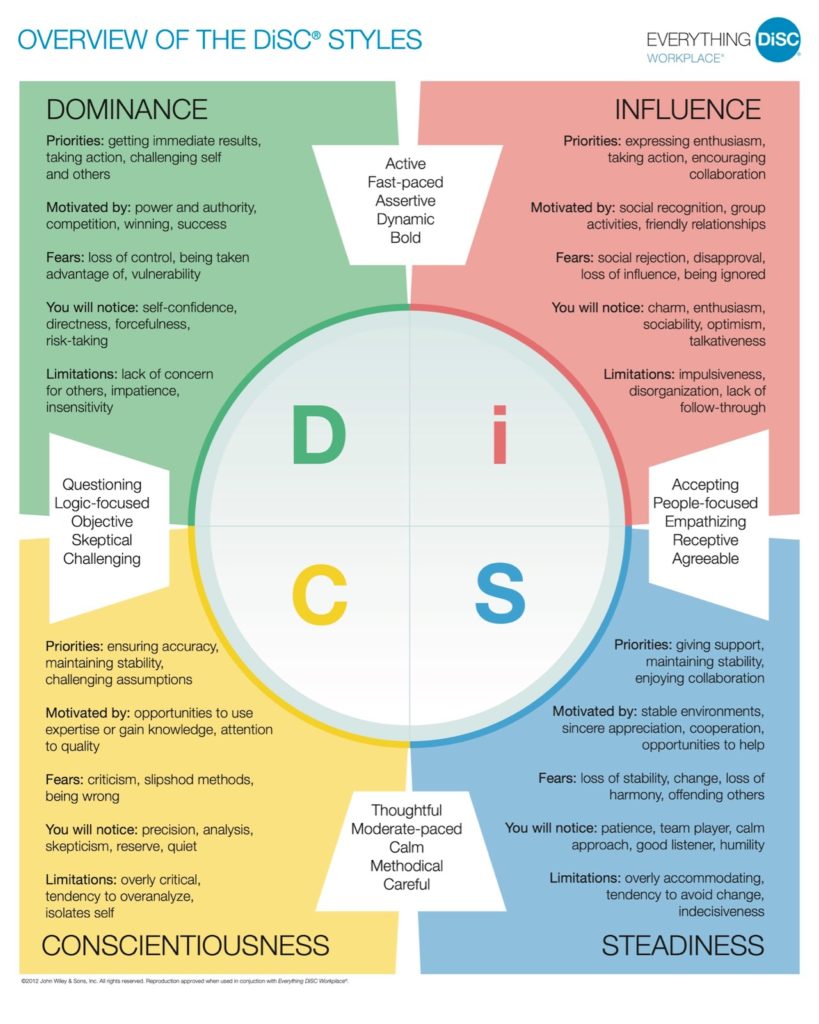What is the DiSC assessment, and how can it help you become a better leader? We’re glad you asked. Today we’ll be exploring this insightful tool that can help you understand yourself and your coworkers better.
The DiSC theory was developed in the 1960s by Dr. William M. Marston. As a researcher, academic, psychologist, philosopher, and writer, he made a significant impact on history. Among his accomplishments is the invention of the polygraph machine, or lie detector, and the creation of the DC Comic book character Wonder Woman.
His research measured human behavior and sought to categorize the main emotions and tendencies we experience. His findings later were used to create the DiSC assessment. The framework involves four main quadrants of traits, but with all combinations there are 12 possible workplace styles. D represents dominance, I is influence, S is steadiness, and C is conscientiousness.
Check out the diagram below for a full overview of the DiSC styles, and download a printable version here.

DiSC gives us the opportunity to understand our core tendencies and behaviors, and how we interact with others. There are many DiSC products in the marketplace, and our team selected the materials from Wiley because of the heavy emphasis they put in research and development with their DiSC products and profiles. Jennifer Maxson & Associates is an Everything DiSC® Authorized partner and provides a variety of programming using this tool.
The benefit of doing a DiSC profile is to understand yourself first. What are the key behaviors and tendencies that characterize your actions every day? DiSC is more than just a way to understand yourself better. Ultimately, it helps you build better relationships by understanding the styles of others and how you need to flex to work with their styles. The DiSC framework helps us ask questions like, What are each person’s priorities? What is most important to them? and How does that play out in the workplace?
Each person is a blend of all four DiSC styles. It’s true that we spend more time in one style or style combination based on our tendencies, but we are all very flexible and adaptable. Often it will take extra energy and focus to “flex” outside of our core style.
Let’s look at two coworkers, Sandra and Jim. Sandra’s DiSC style is on the border of S and I. One of her main priorities is collaboration. Jim’s style is more toward D and C. His major priority is challenge. When Jim challenges Sandra’s statement at work, she needs to remember that it’s not a personal attack. He just wants to challenge the information to make sure it’s correct. Jim is concerned with reaching his goal. Sandra, on the other hand, prioritizes harmony and working together. Jim might think, “Why does everybody need to be on the same page to get things done?” Both Sandra and Jim need to become flexible enough to recognize the other person’s perspective and adjust accordingly.
With an understanding of DiSC, you as a leader can watch for behaviors and tendencies in your coworkers and other people on your team. Instead of experiencing different styles as a disruptor or stressor, you can embrace the styles of others and understand how you need to flex in order to support that person.
Ready to learn more? Check out our lineup of DiSC programs here and get in touch with our team for a personalized approach to your workplace and DiSC.

